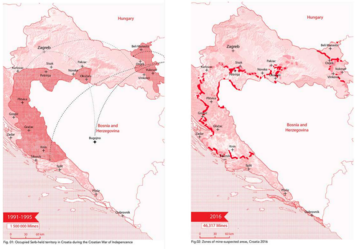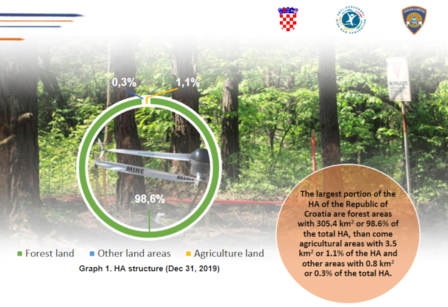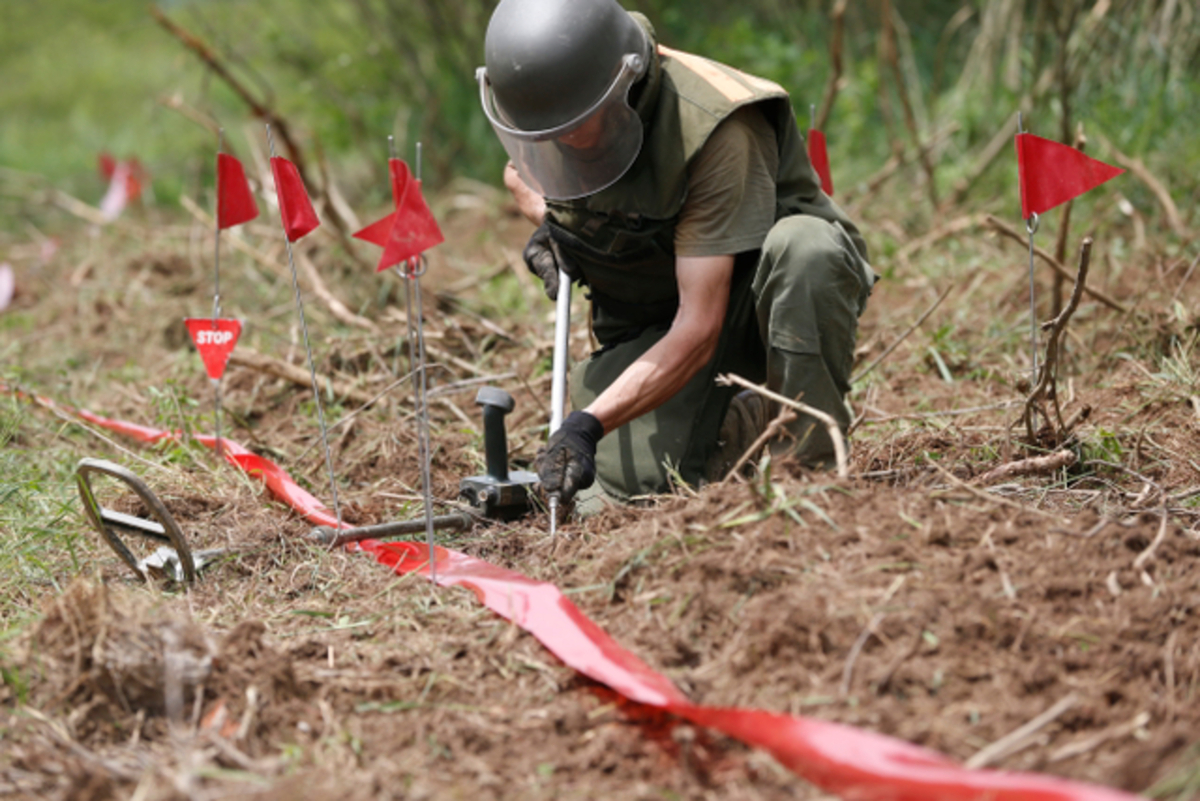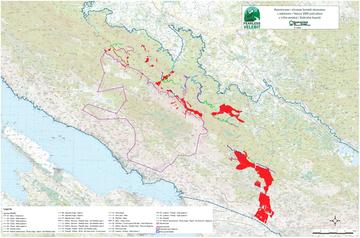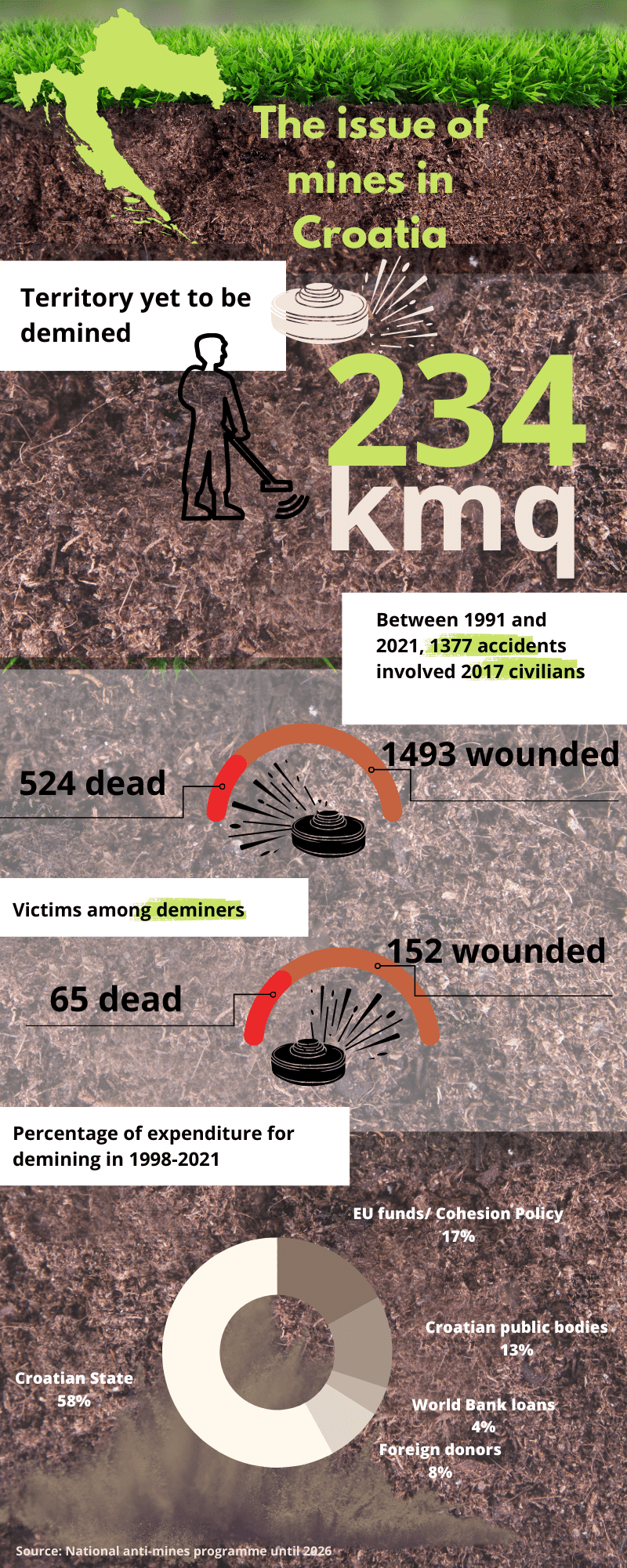Croatia: mines still kill
Despite the extensive demining programme of recent years – also made possible by EU cohesion funds – the mines from the 1990s conflict still claim victims in Croatia
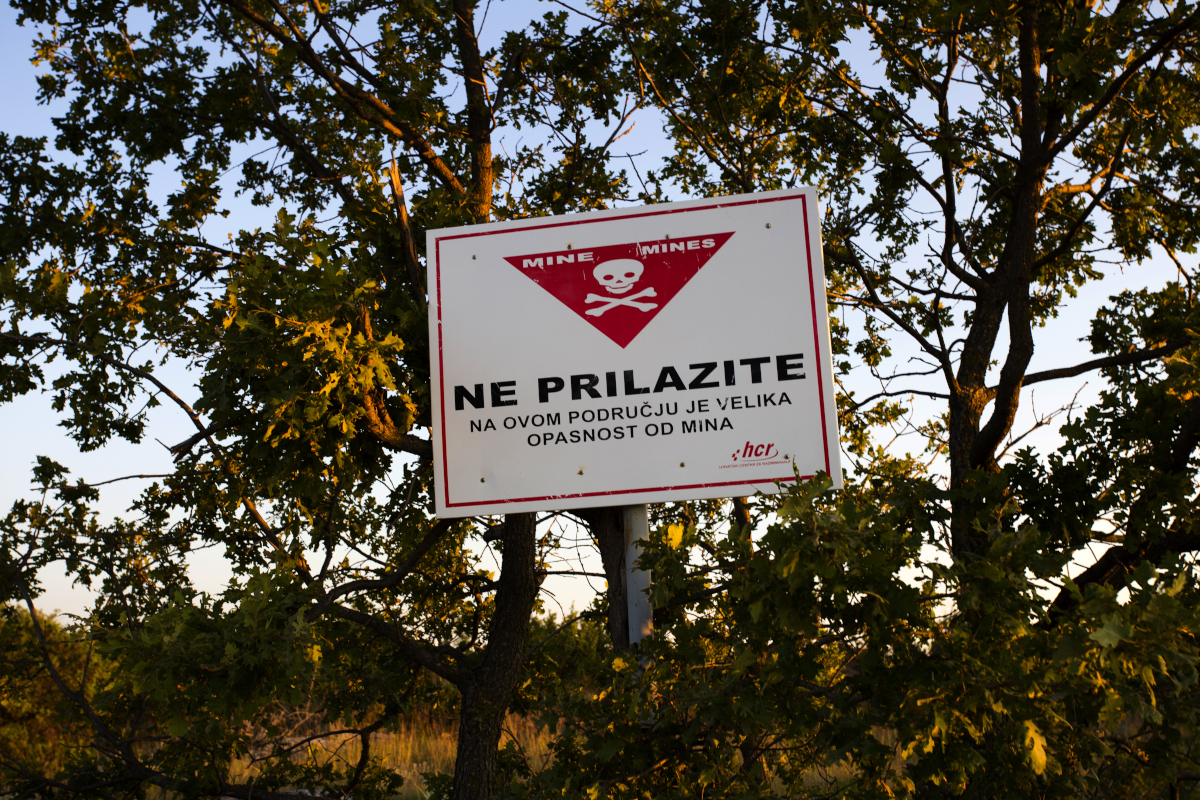
Croazia-le-mine-uccidono-ancora
Croatia – landmine risk passage prohibited (ninopavisic/Shutterstock )
In Croatia, the mines from the conflict which lasted from 1991 to 1995 have not yet been cleared and continue to claim victims. The latest tragedy dates back to 15 January and took place near Mount Dinara, just over 40 km north of Split, in the Dalmatian hinterland. A 67-year-old hunter entered an area marked as "at risk of mines" and was killed by the explosion of a bomb. Between 1991 and 2021 , 2,017 people fell victim to mines and 524 were killed. In addition, 65 deminers died – and hundreds were injured – in the course of clearing operations.
During the war, the whole area of Croatian Krajina was intensely mined, starting from 1991 with the birth of the self-proclaimed Republic of Serbian Krajina (proclaimed on December 19, 1991 by the Croatian Serbs, with the centre of power in Knin, never recognised internationally) until August 1995 with the Oluja operation of the Croatian army.
The following demining work was quite difficult: there were often no maps indicating the position of anti-personnel and anti-tank mines, there were no resources to invest in demining, and the mined territories were often complex to clear.
In Croatia, the first law dedicated to solving mine pollution dates back to 1996, when the United Nations mission in the country estimated the land to be reclaimed at 13,000 sq km (23% of the entire Croatian territory). Then, in 1998, the CROMAC (Croatian Mine Action Centre) was created with the task of coordinating all the initiatives to be able to comply with the Ottawa Convention signed in 1997 (on the ban on the use, storage, production, and transfer of anti-personnel mines and their destruction). On that occasion, the Croatian authorities had assured that they would complete the demining by March 2019, as also envisaged in the National Strategy for Demining 2009-2019 . But in 2018 the terms were extended to 2026.
Furthermore, to facilitate the implementation of the Strategy, since 2015 a new law on demining has provided for a set of precise actions and coordinated procedures – through the renewed Croatian Centre for Demining HCR-CTRO . The law was reformed several times, the last one in view of Croatia’s entry into Schengen and in force since January 1st, 2023.
Invested resources and the EU
Until 2021, the demining operations had cost more than 7 billion kuna (929 million Euros). 224 more million Euros are needed to complete them by 2026, according to data made public in September 2022 by the Croatian parliament. Croatia expects to cover the latter with almost 94 million from the state budget and the rest with foreign and European funds. According to the data published by the Landmine & Cluster Munition Monitor, at the end of 2020 there were 279.55 sq km of territory still contaminated in Croatia, including 196.89 of certainly mined areas and 82.66 of suspect/risk areas.
To date, almost all of these territories (98.6%) is made of forest areas, a third of which (89.8 sq km) Croatia plans to reclaim thanks to EU Cohesion funds .
In this context, the first projects linked to programming up to 2027 are being defined and launched, while the activities of a series of interventions supported by the 2014-2020 programme are still underway. Some are dedicated precisely to the demining of wooded areas overlooking national parks which, when finally safe, could become a further tourist attraction and slow down the strong depopulation of mountain areas due to the lack of employment prospects.
Natural parks and demining
This is the case of the Osjecko-baranjska County, in the "Kopacki Rit Nature Park ", which extends into one of the largest wetlands in Europe north-east of the city of Osijek, and in part of the "Mura Drava Regional Park " – which extends over the territory of five counties in addition to Osijek – and which is one of the most important European river ecosystems. The value of this regional park is also demonstrated by the fact that it is part of UNESCO’s first transnational biosphere born two years ago, called the "Amazon of Europe" and which involves four other countries bordering Croatia.
The two parks are included in the Naturavita project, which has made resources available for 49.9 million Euros. The clearing of 2,534 hectares of forest from mines and war remnants is expected by 2023, alongside other environmental protection activities, infrastructure restructuring, and initiatives to educate and raise awareness among the population, especially young people. With respect to this sector of activity, the creation of the "Podravlje" educational centre, inaugurated in May 2021 in the Dravica forest, in the Mura-Drava regional park, is important. In addition to organising guided tours to get to know the flora and fauna and volunteer camps, the centre is a place for children and young people to receive information on spotting war remnants and the associated dangers.
Then there are two other counties, located behind the towns of Senj and Zara, between the Adriatic coast and the western border between Croatia and Bosnia Herzegovina, which were among the most mined during the 1991-1995 war.
As part of the “Fearless Velebit ” project, covered by European funds and led by the "Hrvatske sume d.o.o." (public enterprise for forest and forest land management in the Republic of Croatia), demining has almost been completed in two areas of Licko-senjska and Zadarska County.
The works are expected to end in June 2023 with the reclamation of 1,645 hectares of wooded and non-wooded areas in the area of the Velebit Nature Park and the Paklenica National Park. The project has also enabled the reclamation of several trekking routes in the southern area of Velebit.
Not only. In the event of fires, in this area of Velebit it will now be possible to operate quickly even on the ground and not only with the Canadairs. This was not possible in August 2017, when due to the failure to check for the presence of mines in an area considered at risk, a large forest area caught fire near Paklenica Park, between Sveto Brdo and Crveni Potok.
European funds were also used for the "Karlovac Karst " project, in the south-western territory of the county of the same name, where the first conference between the project partners was organised in September 2022, led by the "Hrvatske sume d.o.o.”. 1,929.08 hectares are expected to be demined for a cost of 32 million Euros, 81% covered by the EU.
In May, Croatia will share this 20-year-long experience with operators in the sector, in the annual International Symposium on the fight against mines, that it has organised for some time and which will be held in Vodice (Sibenik), dedicated to the exchange of experiences, information on the latest technologies, equipment and methods in action, and search for solutions to new technical and management challenges. Among the four thematic areas that will be addressed, one will be dedicated to urgent responses to the situation in Ukraine. A country with which Croatia has already had cooperation relationships, to share its experience in the field of demining – with the "UDS Ukrainian Deminers Association ", for the territories involved in the 2014 conflict in Donbass – then suspended due to the Russian invasion a year ago.
This content is published in the context of the “Work4Future” project co-financed by the European Union (EU). The EU is in no way responsible for the information or views expressed within the framework of the project. The responsibility for the contents lies solely with OBC Transeuropa. Go to the “Work4Future“
Tag: Work for Future
Featured articles
- Take part in the survey
Croatia: mines still kill
Despite the extensive demining programme of recent years – also made possible by EU cohesion funds – the mines from the 1990s conflict still claim victims in Croatia

Croazia-le-mine-uccidono-ancora
Croatia – landmine risk passage prohibited (ninopavisic/Shutterstock )
In Croatia, the mines from the conflict which lasted from 1991 to 1995 have not yet been cleared and continue to claim victims. The latest tragedy dates back to 15 January and took place near Mount Dinara, just over 40 km north of Split, in the Dalmatian hinterland. A 67-year-old hunter entered an area marked as "at risk of mines" and was killed by the explosion of a bomb. Between 1991 and 2021 , 2,017 people fell victim to mines and 524 were killed. In addition, 65 deminers died – and hundreds were injured – in the course of clearing operations.
During the war, the whole area of Croatian Krajina was intensely mined, starting from 1991 with the birth of the self-proclaimed Republic of Serbian Krajina (proclaimed on December 19, 1991 by the Croatian Serbs, with the centre of power in Knin, never recognised internationally) until August 1995 with the Oluja operation of the Croatian army.
The following demining work was quite difficult: there were often no maps indicating the position of anti-personnel and anti-tank mines, there were no resources to invest in demining, and the mined territories were often complex to clear.
In Croatia, the first law dedicated to solving mine pollution dates back to 1996, when the United Nations mission in the country estimated the land to be reclaimed at 13,000 sq km (23% of the entire Croatian territory). Then, in 1998, the CROMAC (Croatian Mine Action Centre) was created with the task of coordinating all the initiatives to be able to comply with the Ottawa Convention signed in 1997 (on the ban on the use, storage, production, and transfer of anti-personnel mines and their destruction). On that occasion, the Croatian authorities had assured that they would complete the demining by March 2019, as also envisaged in the National Strategy for Demining 2009-2019 . But in 2018 the terms were extended to 2026.
Furthermore, to facilitate the implementation of the Strategy, since 2015 a new law on demining has provided for a set of precise actions and coordinated procedures – through the renewed Croatian Centre for Demining HCR-CTRO . The law was reformed several times, the last one in view of Croatia’s entry into Schengen and in force since January 1st, 2023.
Invested resources and the EU
Until 2021, the demining operations had cost more than 7 billion kuna (929 million Euros). 224 more million Euros are needed to complete them by 2026, according to data made public in September 2022 by the Croatian parliament. Croatia expects to cover the latter with almost 94 million from the state budget and the rest with foreign and European funds. According to the data published by the Landmine & Cluster Munition Monitor, at the end of 2020 there were 279.55 sq km of territory still contaminated in Croatia, including 196.89 of certainly mined areas and 82.66 of suspect/risk areas.
To date, almost all of these territories (98.6%) is made of forest areas, a third of which (89.8 sq km) Croatia plans to reclaim thanks to EU Cohesion funds .
In this context, the first projects linked to programming up to 2027 are being defined and launched, while the activities of a series of interventions supported by the 2014-2020 programme are still underway. Some are dedicated precisely to the demining of wooded areas overlooking national parks which, when finally safe, could become a further tourist attraction and slow down the strong depopulation of mountain areas due to the lack of employment prospects.
Natural parks and demining
This is the case of the Osjecko-baranjska County, in the "Kopacki Rit Nature Park ", which extends into one of the largest wetlands in Europe north-east of the city of Osijek, and in part of the "Mura Drava Regional Park " – which extends over the territory of five counties in addition to Osijek – and which is one of the most important European river ecosystems. The value of this regional park is also demonstrated by the fact that it is part of UNESCO’s first transnational biosphere born two years ago, called the "Amazon of Europe" and which involves four other countries bordering Croatia.
The two parks are included in the Naturavita project, which has made resources available for 49.9 million Euros. The clearing of 2,534 hectares of forest from mines and war remnants is expected by 2023, alongside other environmental protection activities, infrastructure restructuring, and initiatives to educate and raise awareness among the population, especially young people. With respect to this sector of activity, the creation of the "Podravlje" educational centre, inaugurated in May 2021 in the Dravica forest, in the Mura-Drava regional park, is important. In addition to organising guided tours to get to know the flora and fauna and volunteer camps, the centre is a place for children and young people to receive information on spotting war remnants and the associated dangers.
Then there are two other counties, located behind the towns of Senj and Zara, between the Adriatic coast and the western border between Croatia and Bosnia Herzegovina, which were among the most mined during the 1991-1995 war.
As part of the “Fearless Velebit ” project, covered by European funds and led by the "Hrvatske sume d.o.o." (public enterprise for forest and forest land management in the Republic of Croatia), demining has almost been completed in two areas of Licko-senjska and Zadarska County.
The works are expected to end in June 2023 with the reclamation of 1,645 hectares of wooded and non-wooded areas in the area of the Velebit Nature Park and the Paklenica National Park. The project has also enabled the reclamation of several trekking routes in the southern area of Velebit.
Not only. In the event of fires, in this area of Velebit it will now be possible to operate quickly even on the ground and not only with the Canadairs. This was not possible in August 2017, when due to the failure to check for the presence of mines in an area considered at risk, a large forest area caught fire near Paklenica Park, between Sveto Brdo and Crveni Potok.
European funds were also used for the "Karlovac Karst " project, in the south-western territory of the county of the same name, where the first conference between the project partners was organised in September 2022, led by the "Hrvatske sume d.o.o.”. 1,929.08 hectares are expected to be demined for a cost of 32 million Euros, 81% covered by the EU.
In May, Croatia will share this 20-year-long experience with operators in the sector, in the annual International Symposium on the fight against mines, that it has organised for some time and which will be held in Vodice (Sibenik), dedicated to the exchange of experiences, information on the latest technologies, equipment and methods in action, and search for solutions to new technical and management challenges. Among the four thematic areas that will be addressed, one will be dedicated to urgent responses to the situation in Ukraine. A country with which Croatia has already had cooperation relationships, to share its experience in the field of demining – with the "UDS Ukrainian Deminers Association ", for the territories involved in the 2014 conflict in Donbass – then suspended due to the Russian invasion a year ago.
This content is published in the context of the “Work4Future” project co-financed by the European Union (EU). The EU is in no way responsible for the information or views expressed within the framework of the project. The responsibility for the contents lies solely with OBC Transeuropa. Go to the “Work4Future“
Tag: Work for Future

